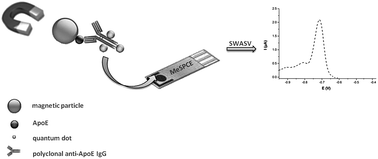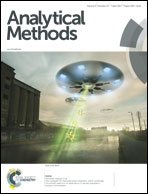An advanced conjugation strategy for the preparation of quantum dot-antibody immunoprobes
Abstract
An advanced site-specific conjugation strategy for the preparation of quantum dot-based antibody probes applicable in various immunoassays from fluorescence to electrochemical biosensors is described. The combination of antigen (protein ApoE) modified magnetic particles providing protection to antibody binding sites, simple carbodiimide chemistry and carboxylate quantum dots (QDs) made of CdSe/ZnS is used for efficient labelling of anti-ApoE antibodies representing a model system. Polyacrylamide gel electrophoresis, fluorescence spectra measurements, capillary electrophoresis-laser induced fluorescence (CE-LIF) and square wave anodic stripping voltammetry (SWASV) were used for experimental verification of labelling efficiency. A simple change in antibody type makes this approach versatile and exploitable in a wide range of applications.



 Please wait while we load your content...
Please wait while we load your content...